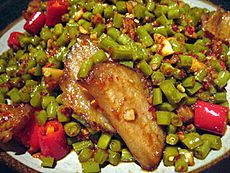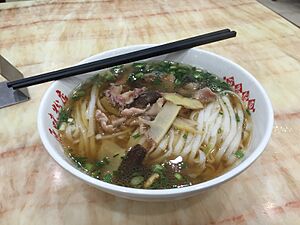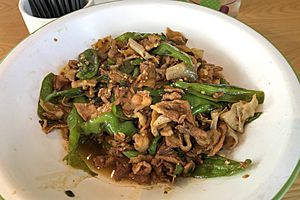Hunan cuisine facts for kids
Quick facts for kids Hunan cuisine |
|||||||||
|---|---|---|---|---|---|---|---|---|---|

Hunan cured ham with pickled yardlong beans
|
|||||||||
| Chinese | 湖南菜 | ||||||||
|
|||||||||
| Xiang cuisine | |||||||||
| Chinese | 湘菜 | ||||||||
|
|||||||||
Hunan cuisine, also called Xiang cuisine, is a famous style of cooking from the Hunan Province in China. It comes from the areas around the Xiang River, Dongting Lake, and western Hunan. It is one of the "Eight Great Traditions" of Chinese food. This cuisine is famous for its very hot and spicy flavors. It also has a fresh smell and deep, rich colors.
Common ways to cook Hunan dishes include stewing, frying, pot-roasting, braising, and smoking. The Hunan region grows a lot of different foods. This means that many kinds of ingredients are used in Hunan dishes.
History of Hunan Food
The cooking skills used in Hunan cuisine have a long history. They date back to the 1600s! People first wrote about chili peppers being used in Hunan in 1684. Over time, Hunan cuisine brought together many local cooking styles. This helped it become its own unique style.
Some well-known dishes from Hunan include fried chicken with spicy sauce (simplified Chinese: 麻辣鸡丁; traditional Chinese: 麻辣雞丁; pinyin: málà jīdīng). Another popular dish is smoked pork with dried long green beans (simplified Chinese: 干豆角蒸腊肉; traditional Chinese: 干豆角蒸臘肉; pinyin: gāndòujiǎo zhēng làròu).
Hunan cuisine has three main styles:
- Xiang River style: This style comes from cities like Changsha, Xiangtan, and Hengyang.
- Dongting Lake style: This style is from areas like Yueyang, Yiyang, and Changde.
- Western Hunan style: This style comes from places like Zhangjiajie, Jishou, and Huaihua.
What Makes Hunan Food Special?
Hunan cuisine uses a lot of chili peppers, shallots, and garlic. It is known for being gan la (Chinese: 干辣; pinyin: gān là; literally "dry and spicy"). This means it is purely hot. People often compare it to Sichuan cuisine. However, Sichuan food uses a special "ma la" (Chinese: 麻辣; pinyin: má là; literally "spicy and numbing") seasoning. This seasoning makes your mouth feel tingly and numb. Sichuan cuisine also uses Sichuan pepper and often dried chilies.
Hunan cuisine is usually spicier because it uses more fresh chili peppers. It also has a wider variety of fresh ingredients. Both Hunan and Sichuan foods can be quite oily. But Sichuan dishes are generally oilier than Hunan dishes. Another big difference is that Hunan cuisine uses smoked and cured foods much more often.
The menu for Hunan cuisine changes with the seasons. In the hot and humid summer, meals often start with cold dishes. These might include cold meats with chilies. This helps to open your pores and keep you cool. In winter, a popular choice is the hot pot. People believe it helps warm your blood in the cold months. There is a special hot pot called yuanyang huoguo (simplified Chinese: 鸳鸯火锅; traditional Chinese: 鴛鴦火鍋; pinyin: yuānyāng hǔogūo; literally "Mandarin ducks hot pot"). This pot is split into two sides. One side is spicy, and the other is mild. A classic Hunan dish is farmer pepper fried pork. It is made with pork belly, green pepper, fermented black beans, and other spices.
Popular Hunan Dishes
| English Name | Traditional Chinese | Simplified Chinese | Pinyin |
|---|---|---|---|
| Changsha-style rice vermicelli | 長沙米粉 | 长沙米粉 | chǎngshā mǐfěn |
| Changde-style stewed beef with rice vermicelli | 常德牛肉粉 | 常德牛肉粉 | chángdé niúròu fěn |
| Changsha stinky tofu | 長沙臭豆腐 | 长沙臭豆腐 | chǎngshā chòu dòufu |
| Cured ham with cowpeas | 酸豆角炒臘肉 | 酸豆角炒腊肉 | suān dòujiǎo chǎo làròu |
| Dong'an chicken | 東安子雞 | 东安子鸡 | dōng'ān zǐjī |
| "Dry-wok" chicken | 干鍋雞 | 干锅鸡 | gānguō jī |
| Home-style tofu | 家常豆腐 | 家常豆腐 | jiācháng dòufǔ |
| Lotus seeds in rock sugar syrup | 冰糖湘蓮 | 冰糖湘莲 | bīngtáng xiānglián |
| Mao's braised pork | 毛氏紅燒肉 | 毛氏红烧肉 | Máo shì hóngshāo ròu |
| Mala chicken | 麻辣子雞 | 麻辣子鸡 | málà zǐjī |
| Mashed shrimp in lotus pod | 蓮藕蝦仁 | 莲藕虾仁 | lián'ǒu xiārén |
| Pearly meatballs | 珍珠肉丸 | 珍珠肉丸 | zhēnzhū ròuwán |
| Pumpkin cake | 南瓜餅 | 南瓜饼 | nánguā bǐng |
| Sautéed pork with chili pepper | 農家小炒肉 | 农家小炒肉 | nóngjiā xiǎo chǎoròu |
| Smoky flavors steamed together | 臘味合蒸 | 腊味合蒸 | làwèi hézhēng |
| Spare ribs steamed in bamboo | 竹筒蒸排骨 | 竹筒蒸排骨 | zhútǒng zhēng páigǔ |
| Spicy crawfish | 香辣口味蝦 | 香辣口味虾 | xiāng là kǒu wèi xiā |
| Steamed fish head in chili sauce | 剁椒蒸魚頭 | 剁椒蒸鱼头 | duòjiāo zhēng yútóu |
| Stir fried duck blood | 炒血鴨 | 炒血鸭 | chǎoxuéyā |
| Stir fried meat with douchi and chili peppers | 豆豉辣椒炒肉 | 豆豉辣椒炒肉 | dòuchǐ làjiāo chǎoròu |
| Yongfeng chili sauce | 永豐辣醬 | 永丰辣酱 | yǒng fēng làjiàng |
Many Hunan dishes are quite spicy, but not all of them are super hot.
See also
 In Spanish: Gastronomía de Hunan para niños
In Spanish: Gastronomía de Hunan para niños



